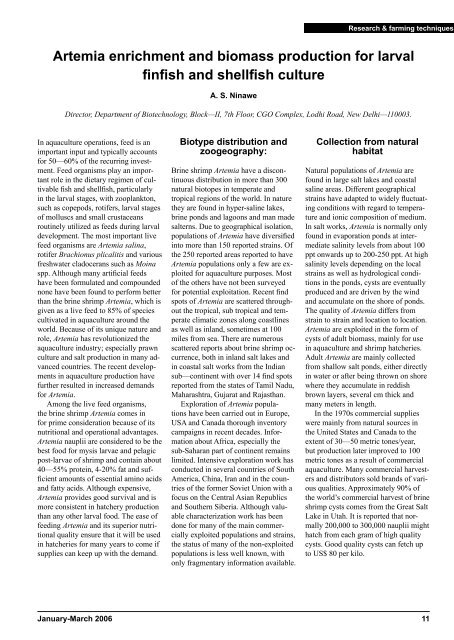Farming carps in leased ponds, Bangladesh - Library - NACA
Farming carps in leased ponds, Bangladesh - Library - NACA
Farming carps in leased ponds, Bangladesh - Library - NACA
Create successful ePaper yourself
Turn your PDF publications into a flip-book with our unique Google optimized e-Paper software.
January-March 2006<br />
Research & farm<strong>in</strong>g techniques<br />
Artemia enrichment and biomass production for larval<br />
fi nfi sh and shellfi sh culture<br />
A. S. N<strong>in</strong>awe<br />
Director, Department of Biotechnology, Block—II, 7th Floor, CGO Complex, Lodhi Road, New Delhi—110003.<br />
In aquaculture operations, feed is an<br />
important <strong>in</strong>put and typically accounts<br />
for 50—60% of the recurr<strong>in</strong>g <strong>in</strong>vestment.<br />
Feed organisms play an important<br />
role <strong>in</strong> the dietary regimen of cultivable<br />
fi sh and shellfi sh, particularly<br />
<strong>in</strong> the larval stages, with zooplankton,<br />
such as copepods, rotifers, larval stages<br />
of molluscs and small crustaceans<br />
rout<strong>in</strong>ely utilized as feeds dur<strong>in</strong>g larval<br />
development. The most important live<br />
feed organisms are Artemia sal<strong>in</strong>a,<br />
rotifer Brachionus plicalitis and various<br />
freshwater cladocerans such as Mo<strong>in</strong>a<br />
spp. Although many artifi cial feeds<br />
have been formulated and compounded<br />
none have been found to perform better<br />
than the br<strong>in</strong>e shrimp Artemia, which is<br />
given as a live feed to 85% of species<br />
cultivated <strong>in</strong> aquaculture around the<br />
world. Because of its unique nature and<br />
role, Artemia has revolutionized the<br />
aquaculture <strong>in</strong>dustry; especially prawn<br />
culture and salt production <strong>in</strong> many advanced<br />
countries. The recent developments<br />
<strong>in</strong> aquaculture production have<br />
further resulted <strong>in</strong> <strong>in</strong>creased demands<br />
for Artemia.<br />
Among the live feed organisms,<br />
the br<strong>in</strong>e shrimp Artemia comes <strong>in</strong><br />
for prime consideration because of its<br />
nutritional and operational advantages.<br />
Artemia nauplii are considered to be the<br />
best food for mysis larvae and pelagic<br />
post-larvae of shrimp and conta<strong>in</strong> about<br />
40—55% prote<strong>in</strong>, 4-20% fat and suffi<br />
cient amounts of essential am<strong>in</strong>o acids<br />
and fatty acids. Although expensive,<br />
Artemia provides good survival and is<br />
more consistent <strong>in</strong> hatchery production<br />
than any other larval food. The ease of<br />
feed<strong>in</strong>g Artemia and its superior nutritional<br />
quality ensure that it will be used<br />
<strong>in</strong> hatcheries for many years to come if<br />
supplies can keep up with the demand.<br />
Biotype distribution and<br />
zoogeography:<br />
Br<strong>in</strong>e shrimp Artemia have a discont<strong>in</strong>uous<br />
distribution <strong>in</strong> more than 300<br />
natural biotopes <strong>in</strong> temperate and<br />
tropical regions of the world. In nature<br />
they are found <strong>in</strong> hyper-sal<strong>in</strong>e lakes,<br />
br<strong>in</strong>e <strong>ponds</strong> and lagoons and man made<br />
salterns. Due to geographical isolation,<br />
populations of Artemia have diversifi ed<br />
<strong>in</strong>to more than 150 reported stra<strong>in</strong>s. Of<br />
the 250 reported areas reported to have<br />
Artemia populations only a few are exploited<br />
for aquaculture purposes. Most<br />
of the others have not been surveyed<br />
for potential exploitation. Recent fi nd<br />
spots of Artemia are scattered throughout<br />
the tropical, sub tropical and temperate<br />
climatic zones along coastl<strong>in</strong>es<br />
as well as <strong>in</strong>land, sometimes at 100<br />
miles from sea. There are numerous<br />
scattered reports about br<strong>in</strong>e shrimp occurrence,<br />
both <strong>in</strong> <strong>in</strong>land salt lakes and<br />
<strong>in</strong> coastal salt works from the Indian<br />
sub—cont<strong>in</strong>ent with over 14 fi nd spots<br />
reported from the states of Tamil Nadu,<br />
Maharashtra, Gujarat and Rajasthan.<br />
Exploration of Artemia populations<br />
have been carried out <strong>in</strong> Europe,<br />
USA and Canada thorough <strong>in</strong>ventory<br />
campaigns <strong>in</strong> recent decades. Information<br />
about Africa, especially the<br />
sub-Saharan part of cont<strong>in</strong>ent rema<strong>in</strong>s<br />
limited. Intensive exploration work has<br />
conducted <strong>in</strong> several countries of South<br />
America, Ch<strong>in</strong>a, Iran and <strong>in</strong> the countries<br />
of the former Soviet Union with a<br />
focus on the Central Asian Republics<br />
and Southern Siberia. Although valuable<br />
characterization work has been<br />
done for many of the ma<strong>in</strong> commercially<br />
exploited populations and stra<strong>in</strong>s,<br />
the status of many of the non-exploited<br />
populations is less well known, with<br />
only fragmentary <strong>in</strong>formation available.<br />
Collection from natural<br />
habitat<br />
Natural populations of Artemia are<br />
found <strong>in</strong> large salt lakes and coastal<br />
sal<strong>in</strong>e areas. Different geographical<br />
stra<strong>in</strong>s have adapted to widely fl uctuat<strong>in</strong>g<br />
conditions with regard to temperature<br />
and ionic composition of medium.<br />
In salt works, Artemia is normally only<br />
found <strong>in</strong> evaporation <strong>ponds</strong> at <strong>in</strong>termediate<br />
sal<strong>in</strong>ity levels from about 100<br />
ppt onwards up to 200-250 ppt. At high<br />
sal<strong>in</strong>ity levels depend<strong>in</strong>g on the local<br />
stra<strong>in</strong>s as well as hydrological conditions<br />
<strong>in</strong> the <strong>ponds</strong>, cysts are eventually<br />
produced and are driven by the w<strong>in</strong>d<br />
and accumulate on the shore of <strong>ponds</strong>.<br />
The quality of Artemia differs from<br />
stra<strong>in</strong> to stra<strong>in</strong> and location to location.<br />
Artemia are exploited <strong>in</strong> the form of<br />
cysts of adult biomass, ma<strong>in</strong>ly for use<br />
<strong>in</strong> aquaculture and shrimp hatcheries.<br />
Adult Artemia are ma<strong>in</strong>ly collected<br />
from shallow salt <strong>ponds</strong>, either directly<br />
<strong>in</strong> water or after be<strong>in</strong>g thrown on shore<br />
where they accumulate <strong>in</strong> reddish<br />
brown layers, several cm thick and<br />
many meters <strong>in</strong> length.<br />
In the 1970s commercial supplies<br />
were ma<strong>in</strong>ly from natural sources <strong>in</strong><br />
the United States and Canada to the<br />
extent of 30—50 metric tones/year,<br />
but production later improved to 100<br />
metric tones as a result of commercial<br />
aquaculture. Many commercial harvesters<br />
and distributors sold brands of various<br />
qualities. Approximately 90% of<br />
the world’s commercial harvest of br<strong>in</strong>e<br />
shrimp cysts comes from the Great Salt<br />
Lake <strong>in</strong> Utah. It is reported that normally<br />
200,000 to 300,000 nauplii might<br />
hatch from each gram of high quality<br />
cysts. Good quality cysts can fetch up<br />
to US$ 80 per kilo.<br />
11

















